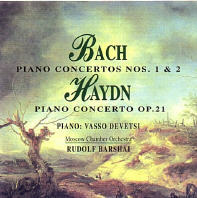By the time the court mourning period was over, Bach had a supply of harpsichord concerti ready to perform, not only his own adaptations but also at least one by his 19-year old son Carl Philipp Emanuel. J.S. Bach's first two are entirely different in emotional content. No. 1 is earnest and powerful, with a particularly strong Baroque character. By contrast, No. 2 is fighter, more forward-looking, and with a moving central Siciliano in C sharp minor. One report suggests that this work may be by Bach's Leipzig associate Christoph Nichelmann (1717-1762).
Mozart, and to a lesser extent Haydn, continued the keyboard concerto tradition into the piano era. The latter's D major Concerto, his most popular, dates from about 1780 and illustrates the move away from Bach's contrapuntal style and into the more racy Classical conventions. After the airy first movement, an Adagio in A major offers a placid melodic interlude. Finally, the movement that has brought the Concerto its popularity, a witty Rondo in Hungarian style. Haydn was living at Esterhazy Castle and would have been familiar with the rhythms and exotic melodies of the surrounding Balkan countryside.
Robert Dearling.
Discontinued
